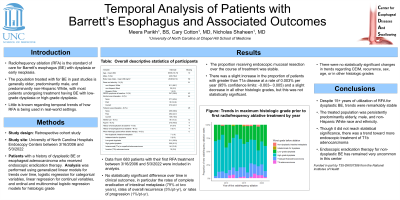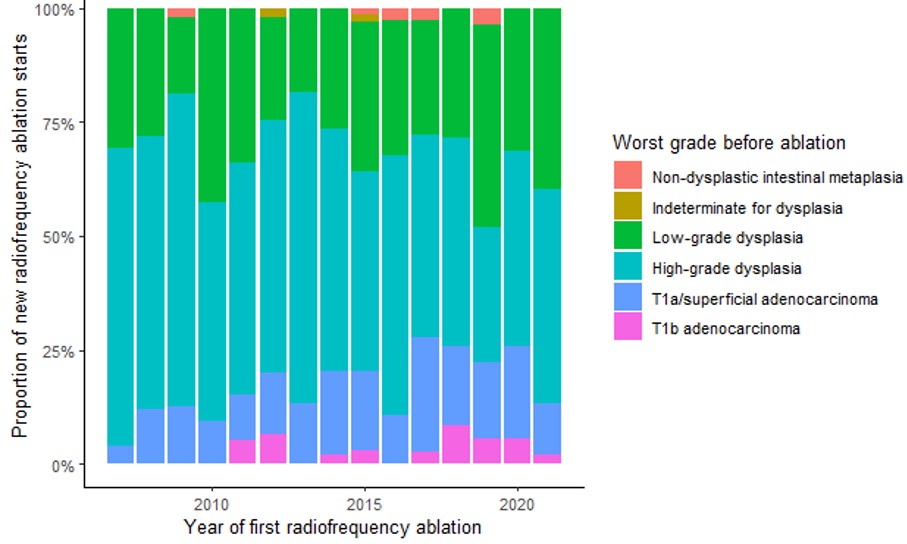Tuesday Poster Session
Category: Esophagus
P3240 - Temporal Analysis of Patients with Barrett’s Esophagus and Associated Outcomes
Tuesday, October 24, 2023
10:30 AM - 4:00 PM PT
Location: Exhibit Hall

Has Audio
- MP
Meera Parikh, BS
University of North Carolina School of Medicine
Chapel Hill, North Carolina
Presenting Author(s)
Meera Parikh, BS1, Cary C.. Cotton, MD, MPH1, Nicholas Shaheen, MD, MPH2
1University of North Carolina School of Medicine, Chapel Hill, NC; 2Universty of North Carolina School of Medicine, Chapel Hill, NC
Introduction: Much is known about the utility of radiofrequency ablation (RFA) in the treatment of Barrett’s esophagus (BE), however, despite 10+ years of utilization, little is known regarding temporal trends about how it is being used and in which patient populations. We aimed to assess trends in age, sex, worst histologic grade prior to ablation, and use of endoscopic mucosal resection in patients treated with radiofrequency ablation.
Methods: We performed a retrospective cohort study of all patients with a history of dysplastic BE or superficial esophageal adenocarcinoma who received endoscopic eradication therapy at the University of North Carolina Hospitals Endoscopy Centers from 2006 to May 3, 2022. All patients who received RFA for BE, either alone or in combination with other modalities, were included. We used generalized linear models to estimate the trends over time, using logistic regression for categorical variables, linear regression for continuous variables, and an ordinal and multinomial logistic regression model for the histologic grade. We set a prior statistical significance threshold of p < 0.05.
Results: 683 patients with first ablation from March 16, 2006 to May 2, 2022 were included for analysis (Table). There was no statistically significant difference over time in the rates of complete eradication of intestinal metaplasia, the rates of overall recurrence, sex assigned at birth, age at referral, the proportion receiving endoscopic mucosal resection over the course of the study, or the overall distribution of maximum histologic grade (Figure) prior to ablative therapy. While there was a slight increase in the proportion of patients with greater than T1a disease at a rate of 0.003% per year (95% confidence limits: -0.003 - 0.005) and a slight decrease in all other histologic grades, these changes did not reach statistical significance.
Discussion: This is the largest single-center study in the U.S. to describe trends in ablative therapy in BE over 15+ years. Demographic and disease characteristics of patients were remarkably stable over the history of this cohort. The majority of participants that were treated had high-grade dysplasia or early-stage esophageal adenocarcinoma with under 2% treated without definite dysplasia or neoplasia.

Disclosures:
Meera Parikh, BS1, Cary C.. Cotton, MD, MPH1, Nicholas Shaheen, MD, MPH2. P3240 - Temporal Analysis of Patients with Barrett’s Esophagus and Associated Outcomes, ACG 2023 Annual Scientific Meeting Abstracts. Vancouver, BC, Canada: American College of Gastroenterology.
1University of North Carolina School of Medicine, Chapel Hill, NC; 2Universty of North Carolina School of Medicine, Chapel Hill, NC
Introduction: Much is known about the utility of radiofrequency ablation (RFA) in the treatment of Barrett’s esophagus (BE), however, despite 10+ years of utilization, little is known regarding temporal trends about how it is being used and in which patient populations. We aimed to assess trends in age, sex, worst histologic grade prior to ablation, and use of endoscopic mucosal resection in patients treated with radiofrequency ablation.
Methods: We performed a retrospective cohort study of all patients with a history of dysplastic BE or superficial esophageal adenocarcinoma who received endoscopic eradication therapy at the University of North Carolina Hospitals Endoscopy Centers from 2006 to May 3, 2022. All patients who received RFA for BE, either alone or in combination with other modalities, were included. We used generalized linear models to estimate the trends over time, using logistic regression for categorical variables, linear regression for continuous variables, and an ordinal and multinomial logistic regression model for the histologic grade. We set a prior statistical significance threshold of p < 0.05.
Results: 683 patients with first ablation from March 16, 2006 to May 2, 2022 were included for analysis (Table). There was no statistically significant difference over time in the rates of complete eradication of intestinal metaplasia, the rates of overall recurrence, sex assigned at birth, age at referral, the proportion receiving endoscopic mucosal resection over the course of the study, or the overall distribution of maximum histologic grade (Figure) prior to ablative therapy. While there was a slight increase in the proportion of patients with greater than T1a disease at a rate of 0.003% per year (95% confidence limits: -0.003 - 0.005) and a slight decrease in all other histologic grades, these changes did not reach statistical significance.
Discussion: This is the largest single-center study in the U.S. to describe trends in ablative therapy in BE over 15+ years. Demographic and disease characteristics of patients were remarkably stable over the history of this cohort. The majority of participants that were treated had high-grade dysplasia or early-stage esophageal adenocarcinoma with under 2% treated without definite dysplasia or neoplasia.

Figure: Trends in maximum histologic grade prior to the first radiofrequency ablation treatment by year.
Disclosures:
Meera Parikh indicated no relevant financial relationships.
Cary Cotton indicated no relevant financial relationships.
Nicholas Shaheen indicated no relevant financial relationships.
Meera Parikh, BS1, Cary C.. Cotton, MD, MPH1, Nicholas Shaheen, MD, MPH2. P3240 - Temporal Analysis of Patients with Barrett’s Esophagus and Associated Outcomes, ACG 2023 Annual Scientific Meeting Abstracts. Vancouver, BC, Canada: American College of Gastroenterology.
